Understand and master the optimization of a propeller thruster, or a wind turbine, through the choice of the number of blades depending on the rotation speed:
A quick search of optimum speed, for a given geometry can be executed from the tab "optimize". If you wish, HELICIEL automatically calculates the propeller rotation speed offering the optimum propeller performance for the determined geometry.
But for a more complete analysis should be used "multiple analysis" which offers many views of performance and test options. For example when the propeller is coupled to an electric motor or a generator,the actual rotational speed of the propeller will be the one which balances the engine torque and the load torque.
To determine how fast the spin system, it is easier to make a superposition of torque curves, according to the rotational speed with multiple analysis .
The propellers of air or water and propellers or turbines capture wind, will be treated equally, for the moment.
- Which factors determine the choice of the optimum speed of rotation?
Brief summary of the situation:The apparent wind received by blade elements is composed of the rotational speed and the speed of the fluid (we do not speak here of induced velocity, but of course it must be taken into account) .The efficiency of a propeller is the performance of its elements that can be compared to rotary wing portions. The best performance is achieved if the elements lift / drag ratio , is the highest possible. The best lift / drag ratio is obtained at a specific angle of incidences, which determines the twisting of our blade.
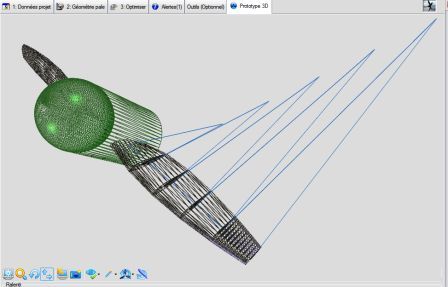
Our blade is twisted for that, the angle between the chord profiles and the direction of the actual speed, corresponds to the incidence providing the best lift / drag ratio of the profile. Lift profiles represent the effective force that we use.
The lift is perpendicular to the apparent wind,but the force that interests us is the thrust (for propulsion propeller) or the torque (as a wind turbine). If the direction of the lift force is aligned with the force we are interested, we can assume that our performance will be optimum ... By varying the speed of rotation we change the direction of the apparent wind so the lift. We can therefore assume that there is a rotational speed directing optimally lift forces..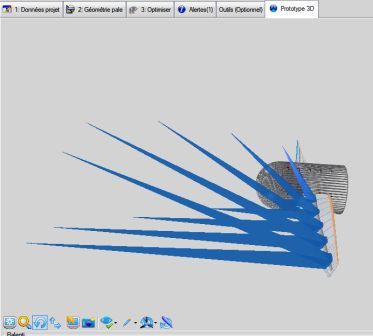
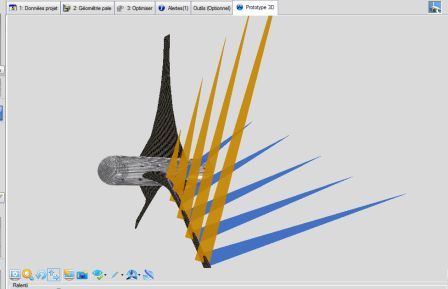
- For a propeller designed to propulsion, the drag and lift should provide maximum thrust for the minimum torque. More the rotational speed is , the higher the apparent velocity seen by the elements, is oriented in the plane of rotation, more the lift is directed in the desired direction of thrust.We say, that the point of view orientation forces, our Optimum speed for a propulsion propeller is the maximum rotational speed, infinie!? infinite? no because there is a limit where the propeller efficiency will decrease.
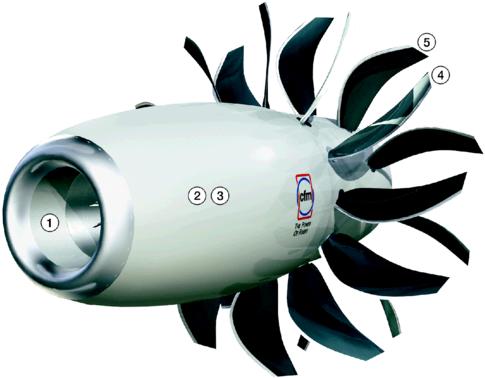
- Another approach, the energy balance between the upstream and downstream of the propeller allows us to understand the interests of a small number of blade and a high speed:
The propulsion effect sought is bound by reaction (Newton's principle) to the acceleration afforded by the propeller to the fluid. But be careful! only The axial acceleration produces thrust, The tangential acceleration (rotating fluid) has no effect of thrust, but only the torque on the shaft. The rotation of the fluid downstream of the propeller is the lost energy. Consequently, two propellers, thrust equal are distinguish by their ability to produce the minimum rotation of the fluid downstream.
The power delivered to the shaft is : Power = torque x speed. By torque reaction (reaction principle of Newton), the fluid is rotated downstream of the propeller (Induction tangential downstream in héliciel). We can therefore say, that for the same power, high rotational speed is associated with a low torque. This torque is directly related to the rotation of the fluid, we can say that with equal power shaft, the propeller will turn faster produce less rotation of the fluid. Power(w)= torque(n.m) X speed rotation(rad/sec).
A propeller equipped with airfoil blades for high speeds, with a low drag would be optimum. But the speed of rotation is limited by other adverse effect (see above) as the masking effect, which leads us to a monopale theoretical optimum propeller. I say "theoretical" because the balancing rotation must be managed on a mechanical level ...
- For a propeller wind turbine or tidal turbine, it is a little trickier.
At first we might think that what we want is the torque! ... the best direction for our lift would be perpendicular to the wind to be fully devoted to the couple. To achieve this , the apparent speed should be parallel to the propeller shaft therefore only composed of the fluid velocity. The Optimum speed is zero, propeller stopped!! To capture all the energy of the fluid through a propeller "stopped",it would take many blades on the disc, and we would still have holes .....The wind turbines pumping with a high torque to operate slow machines in low wind, use this approach. Most modern wind turbines pumping using the interaction between the blades, like sailboat sails, to improve performance, but even the best propeller pump of this type only recover 15% of the energy of the wind.
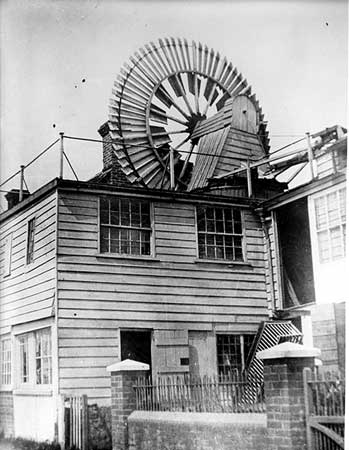
Another approach, the energy balance between the upstream and downstream of the propeller allows us to understand the interests of a small number of blade and a high speed:
- Now think in terms of power(Power(w)= torque(n.m) X speed rotation(rad/sec)) .
- When we capture the kinetic energy of a fluid with a propeller, this energy is converted into torque on the shaft.
- The moment generated by the reaction, (reaction principle of Newton), the fluid is slowed but also rotated (tangential induction).
- The energy balance upstream and downstream, reflecting the collected energy, so the efficiency of the propeller turbine. The propeller capture energy efficient, will be one that leaves less energy downstream.
- Non captured power downstream of the propeller, so is composed of the axial velocity remaining in fluid (the Betz limit), and the tangential velocity induced by torque reaction. For two propeller, whose axial velocity downstream remaining is equivalent,. the propeller which captures the most energy, is the one induces less tangential velocity... Consequently, it is the propeller that will produce the least amount of torque that will generate the least amount of tangential velocity.For the same power with low torque, the propeller must rotate faster. (Power(w)= torque(n.m) X speed rotation(rad/sec)) .
- To avoid losing energy by masking effect between blades (see below)at high speeds, and low wind speed, the lowest number of blade, possible is the most effective to generate greater rotational speed possible..
The "best" propeller does not exist and therefore remains a matter of compromise . Each application must invent its propeller achieving the best compromise.
The performance of our wind turbine propeller is optimum at high rotation speed. The monopale propellers exploit this option considering that the price of only one blade is a certain economye. This type of propeller is theoretically good, but in practice it involves imbalances and speeds, difficult to manage.
We could say that the faster you turn , the better the performance of the propellers are, but Up to what limit?
The main causes limiting high speeds are::- When the propeller turns at low speed the orientation of the apparent wind is distant from the plane of rotation, but as speed increases the apparent wind "lies" in the plane of rotation. At a very high rotational speed the apparent wind can not see passage between the blades if they are too close. La perturbation généré par les pales , The disturbance generated by the blades, so the number of blade reduces the efficiency to high speeds!!
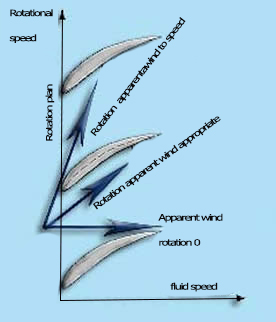
- Cavitation (for a propeller operating in the liquid of course).
- velocity of sound:To speeds close to that of sound, the performance of airfoils, are modified, and phenomena that involve to not exceed this speed. Tests supersonic propellers were made and suggest that it would be possible to exceed these speeds but the noise and supersonic shock are complex to manage.
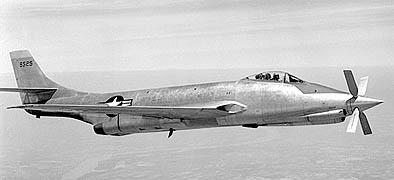
- the centrifugal force and thrust apply mechanical stresses to the blades. Even if the centrifugal force may be used to compensate the thrust by giving a conicity to propellers, materials used sometimes involve limiting rotational speeds. Some manufacturers claim that the lifetime of a wind turbine is inversely proportional to its speed.
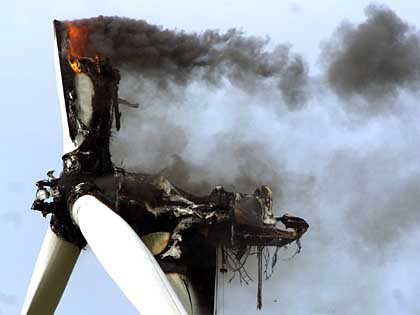
- At high speeds the negative torque generated by the drag of the profiles affecting the efficiency significantly.
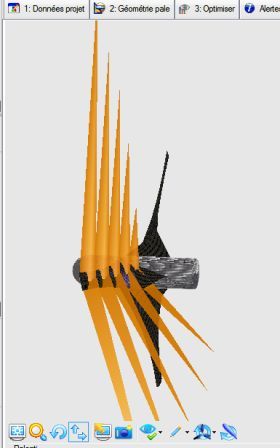
torque and drag on a small wind turbine
conclusion:
We had assumed that the speed of our propeller we were not imposed, but the factors limiting performance are quickly reached.One of the key factors limiting the speed of rotation being the interaction between the blades, optimize the speed of our propeller involve a search of the optimum number of blade.

A further constraint imposed the rotational speed. This is the machine connected to the shaft.. An alternator, a pump, or an air ventilation motor, has characteristics that the propeller must meet. Thus, the speed and torque can be imposed by the machine. If the difference between the optimum rotation speed of the propeller and the optimum rotation speed of the machine is too large, a speed reducer must be installed. But this will decrease performance, increase the cost, weight, and system maintenance. To adjust the speed and torque of a propeller machine, we can play on the geometric parameters of the blades, but the number of blade can help us change the Optimum speed fairly simple.
The number of the blade increases the torque and reduces the optimum rotation speed. So we can adjust our Optimum speed by increasing or decreasing the number of blade.To maintain the performance we must also change the geometry of our blades to reduce the interaction between the blades. As the number of blade increases the blade load decreases, and the thickness of the blades can be decreased. Because it no longer needs to provide much resistance.
The few indications above are tracks, but there is no magic formula to optimize speed and a compromise is always to do.This little article the number of blades of the propeller may also provide some track.
Optimization procedure of the speed of rotation based on performance in héliciel:
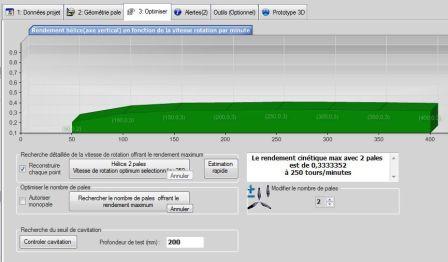
At each change of blade geometry, if the user clicks rebuild HELICIEL rebuilt the optimum twist, for the propeller blades, and updates performance to the operating point imposed. The selected speed determines the twist. But for the reasons we mentioned above, this speed might not be optimum. As we have seen, the parameters optimization of the speed of rotation are numerous and interact in such a way that it is very complex to establish a law of optimization, valid for all propellers.
To find the optimum rotation speed in performance, Héliciel proposes a procedure, of Iterative search. A range of rotation speed is tested, the twists of the propeller are re calculated for each performance and speeds are displayed in a graph. When the maximum efficiency is obtained, the propeller is updated at the optimum rotation speed.. The optimization in terms of performance, gives us the most economical propeller for energy. It is a starting point for the study of the propeller. The layout constraints of our propeller, maybe force us to deviate from the optimum rotation speed, but we will always keep a look at the quality of our propeller through its efficiency.A second optimization procedure optimizes the number of blades: HELICIEL iterates through rotational speed, the first search maximize the propeller, with a minimum blade,the number of blade is then increased again seek the maximum efficiency. As the maximum yield increases the number of blade is increased. When the maximum efficiency is found, the process of optimizing performance stops, and the propeller is rebuilt with the optimum number of blades, for Optimum speed
- Propulsive propellers fans, helicopters: We have seen that the propulsive efficiency of a propeller is zero when the upstream fluid has zero velocity. This is the case of propellers in hover. To help optimize the speeds of all the propeller, the optimization of the propeller is made in terms of kinetic performance. The optimization procedure is therefore stop on the rotational speed providing the best kinetic performance.

- Propeller drive, wind wheel, wind turbine tidal turbine: The optimization procedure will stop on the rotational speed providing the best power coefficient. The power coefficient is the ratio of the output power from the propeller shaft, and the kinetic power of the fluid. Here we see the graph of the evolution of the power coefficient according to the speed. A red line indicates the Betz limit.The optimum rotation speed offers Cp 0.55, This propeller has a near Betz limit Cp, Unfortunately, this performance will be amputated friction bearings losses generator, rectifier, the eventual multiplier, batteries, line losses ... If at the end, we extract 30 to 50% of the Betz limit To produce energy it will be nice.
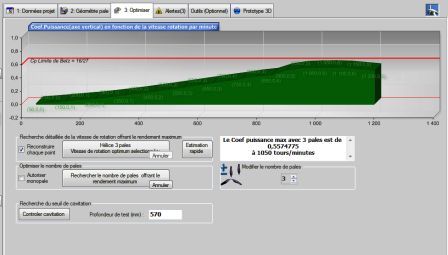
for a more complete analysis should be used "multiple analysis" which offers many views of performance and test options. For example when the propeller is coupled to an electric motor or a generator,the actual rotational speed of the propeller will be the one which balances the engine torque and the load torque.To determine how fast the spin system, it is easier to make a superposition of torque curves, according to the rotational speed with multiple analysis .
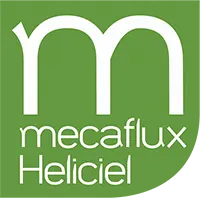
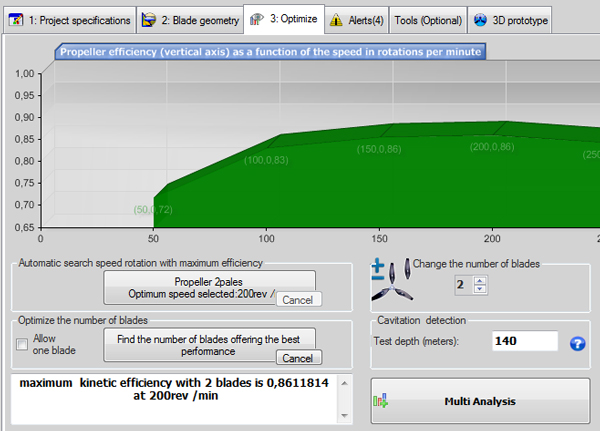
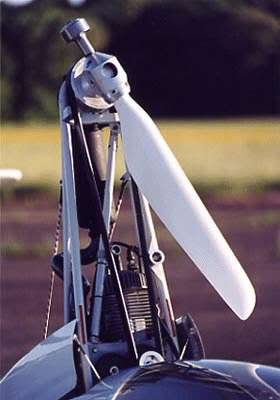
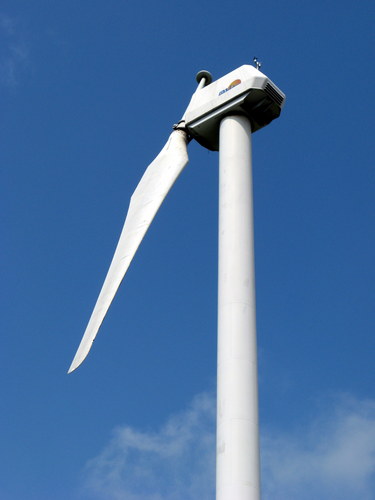
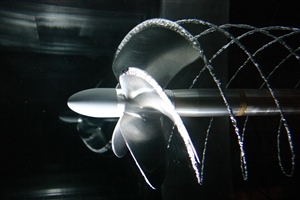
 Global site map
Global site map Mecaflux
Mecaflux Tutorials Mecaflux Pro3D
Tutorials Mecaflux Pro3D Tutorials Heliciel
Tutorials Heliciel Mecaflux Store
Mecaflux Store Compare software functions
Compare software functions Quotes, Orders, Payment Methods
Quotes, Orders, Payment Methods project technical studies
project technical studies